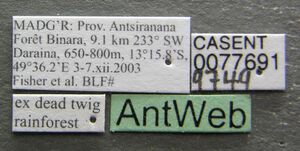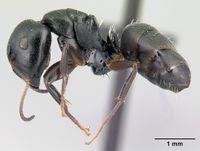Camponotus galoko
| Camponotus galoko | |
|---|---|

| |
| Scientific classification | |
| Kingdom: | Animalia |
| Phylum: | Arthropoda |
| Class: | Insecta |
| Order: | Hymenoptera |
| Family: | Formicidae |
| Subfamily: | Formicinae |
| Tribe: | Camponotini |
| Genus: | Camponotus |
| Subgenus: | Mayria |
| Species group: | edmondi |
| Species: | C. galoko |
| Binomial name | |
| Camponotus galoko Rakotonirina, Csősz & Fisher, 2016 | |
This species is known only from the transitional humid forests of the Daraina and Galoko chain in the north of Madagascar. The data indicate that individual workers forage on lower vegetation, while nests are mostly found in dead twigs above the ground and rarely in rotten logs. (Rakotonirina et al. 2016)
Identification
Rakotonirina et al. (2016) - A member of the Camponotus edmondi species group. In profile, anterior and posterior margins of petiolar node convex; in profile, propodeum strongly compressed anteroposteriorly, without clear distinction between dorsal margin and declivity; in dorsal view, mesonotum twice as broad as long; posterodorsal corner of mesonotum without extended shield.
Camponotus galoko is mostly similar to Camponotus echinoploides, but the posterodorsal corner of the mesonotum in the latter raises into a bluntly rounded shield. Camponotus galoko has a strongly anteroposteriorly flattened propodeum without a clear distinction between the propodeal dorsum and the declivity while the other species in the edmondi group have a propodeal dorsum and a declivitous surface separated by a blunt angle.
The dorsum of the head and mesosoma of C. galoko are densely and finely reticulate whereas those of Camponotus varatra and Camponotus zavo are smooth, shining, and superimposed by imbrication.
Keys including this Species
- Key to Malagasy Camponotus edmondi species group
- Key to Malagasy Camponotus subgenus Mayria minor workers
Distribution
Latitudinal Distribution Pattern
Latitudinal Range: -13.26333° to -13.64609°.
| North Temperate |
North Subtropical |
Tropical | South Subtropical |
South Temperate |
- Source: AntMaps
Distribution based on Regional Taxon Lists
Malagasy Region: Madagascar (type locality).
Distribution based on AntMaps
Distribution based on AntWeb specimens
Check data from AntWeb
Countries Occupied
| Number of countries occupied by this species based on AntWiki Regional Taxon Lists. In general, fewer countries occupied indicates a narrower range, while more countries indicates a more widespread species. |

|
Estimated Abundance
| Relative abundance based on number of AntMaps records per species (this species within the purple bar). Fewer records (to the left) indicates a less abundant/encountered species while more records (to the right) indicates more abundant/encountered species. |

|
Biology
Castes
Worker
Images from AntWeb
   
| |
| Worker (major/soldier). Specimen code casent0077691. Photographer Erin Prado, uploaded by California Academy of Sciences. | Owned by CAS, San Francisco, CA, USA. |
   
| |
| Holotype of Camponotus galoko. Worker. Specimen code casent0178918. Photographer Erin Prado, uploaded by California Academy of Sciences. | Owned by CAS, San Francisco, CA, USA. |
   
| |
| Worker. Specimen code casent0217304. Photographer Erin Prado, uploaded by California Academy of Sciences. | Owned by CAS, San Francisco, CA, USA. |
Nomenclature
The following information is derived from Barry Bolton's Online Catalogue of the Ants of the World.
- galoko. Camponotus galoko Rakotonirina, et al. 2016: 124, figs. 10B, 11B, 25, 40 (s.w.) MADAGASCAR.
- Type-material: holotype worker, 8 paratype workers.
- Type-locality: holotype Madagascar: Antsiranana, Forêt de Binara, 9.1 km. 233° SW Daraina, -13.26333, 49.60333, 650-800 m., 5.xii.2003, BLF09814 (B.L. Fisher, et al.); paratypes with same data.
- Type-depositories: CASC (holotype); BMNH, CASC, MHNG, MSNG (paratypes).
- Distribution: Madagascar.
Unless otherwise noted the text for the remainder of this section is reported from the publication that includes the original description.
Description
Worker
Minor. In full-face view head slightly longer than broad (CWb/CL: 0.94–0.99), slightly diverging posteriorly; posterior margin broadly convex, lateral margins roughly straight. Eyes larger relative to size of head (EL/CS: 0.23–0.25), their posterior level located at about posterior fourth of head (PoOc/CL: 0.2–0.25). Anterior clypeal margin transverse; posterior margin medially notched. Mandible triangular, apical margin armed with six sharp teeth, which reduce in size towards basal angle of the mandible. Antennal scape short (SL/CS: 0.81–0.98), one fourth of the length surpassing posterior cephalic margin. Pronotum flat dorsally, anteriorly projecting into narrow ridge; dorsolateral portion longitudinally marginate. In dorsal view, mesonotum twice as broad as long, posterodorsal corner rounded, without extended lobe; lateral margin convex and strongly convergent posteriorly. Propodeum strongly compressed anteroposterioly, dorsal margin and declivity not distinctly separated; posterolateral portion extending laterally into sharp ridge. Propodeal spiracle on lower third of posterior face of propodeum. Maximum width of procoxa as large as the width of meso-metapleuron and propodeal surface together; femur of foreleg en-larged, twice as large as those of mid-leg and hind leg. Anterior and posterior margins of petiolar node convex. No constriction between abdominal segments III and IV.
Dorsum of head and mesosoma finely and densely reticulate punctate. Mandible finely and densely reticulate superimposed with scattered large punctures. Finer and denser reticulate punctures present on gastral tergites. Pronotum with a few pairs and mesonotum with one pair of whitish erect hairs; whitish hairs gathered at mid-height of posterior face of propodeum; whitish erect hairs present at mid-height of near lateral and on dorsal margins of posterior face of petiolar node; gastral segments with scattered and much shorter erect hairs; pubescence more abundant on gastral tergite than mesosomal dorsum. Integument shining black, antenna brown basally and darker apically; basal portion of mandible and leg dark brown, apical portion and trochanter light brown to yellowish-orange.
Major. Characteristics of minor worker, except: head in full-face view roughly as long as broad (CWb/CL: 0.96–1.03), lateral margins slightly convex and slightly converging near base of mandibles. Eyes smaller relative to head size (EL/CS: 0.19–0.22), their posterior level located roughly at posterior fourth of head (PoOc/ CL: 0.27–0.31). Anterior margin of clypeus truncate and posterior. Antennal scape not extending beyond posterior cephalic margin. In dorsal view, metanotum visible between metanotal groove and propodeum. In lateral view, petiolar node more compressed anteroposteriorly. Lateral portion of head near base of mandible with sparse, large, piligerous punctures.
Rasoamanana and Fisher (2022) - Morphological measurements: see Appendix 1 and Ratios of morphometric data for majors and minors
Type Material
Holotype worker. Madagascar, Province Antsiranana, Forêt de Binara, 9.1 km 233° SW Daraina, –13.26333, 49.60333, 650–800 m, rainforest, ex rotten log, 5 Dec 2003 (B. L. Fisher et al.) collection code BLF09814, specimen code CASENT0178918 (California Academy of Sciences). Paratypes. 8 workers same data as holotype.
References
- Rakotonirina J.C., Csosz S., and B.L. Fisher. 2016. Revision of the Malagasy Camponotus edmondi species group (Hymenoptera, Formicidae, Formicinae): integrating qualitative morphology and multivariate morphometric analysis. ZooKeys. 572:81-154 (doi:10.3897/zookeys.572.7177).
- Rasoamanana, N., Fisher, B.L. 2022. A taxonomic revision of the Malagasy endemic subgenus Mayria of the genus Camponotus (Hymenoptera, Formicidae) based on qualitative morphology and quantitative morphometric analyses. ZooKeys 1081: 137–231 (doi:10.3897/zookeys.1081.71872).

